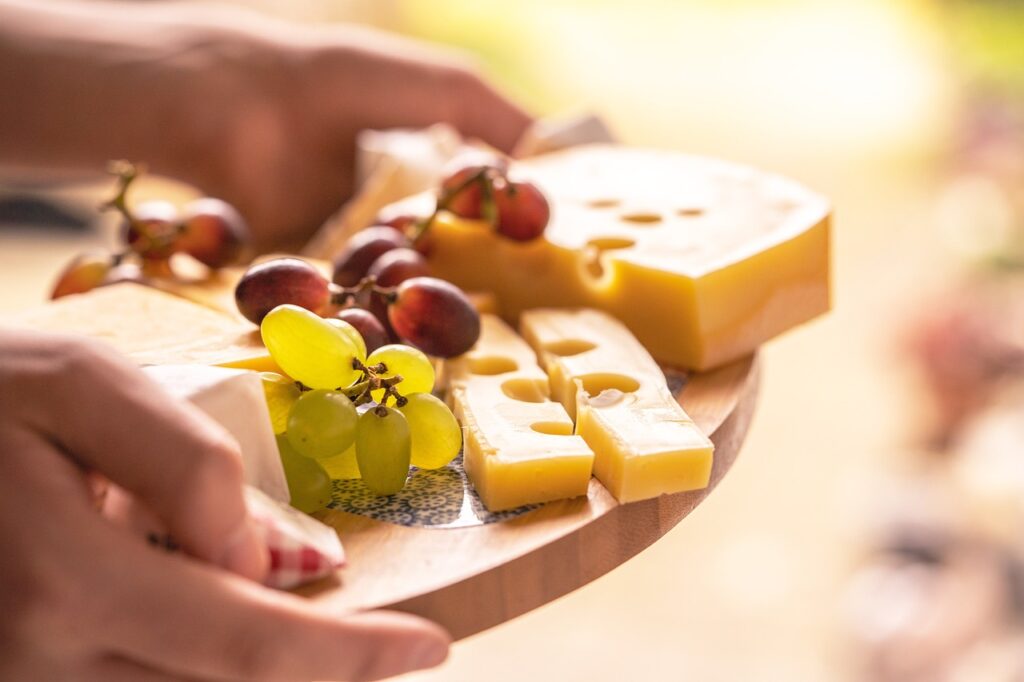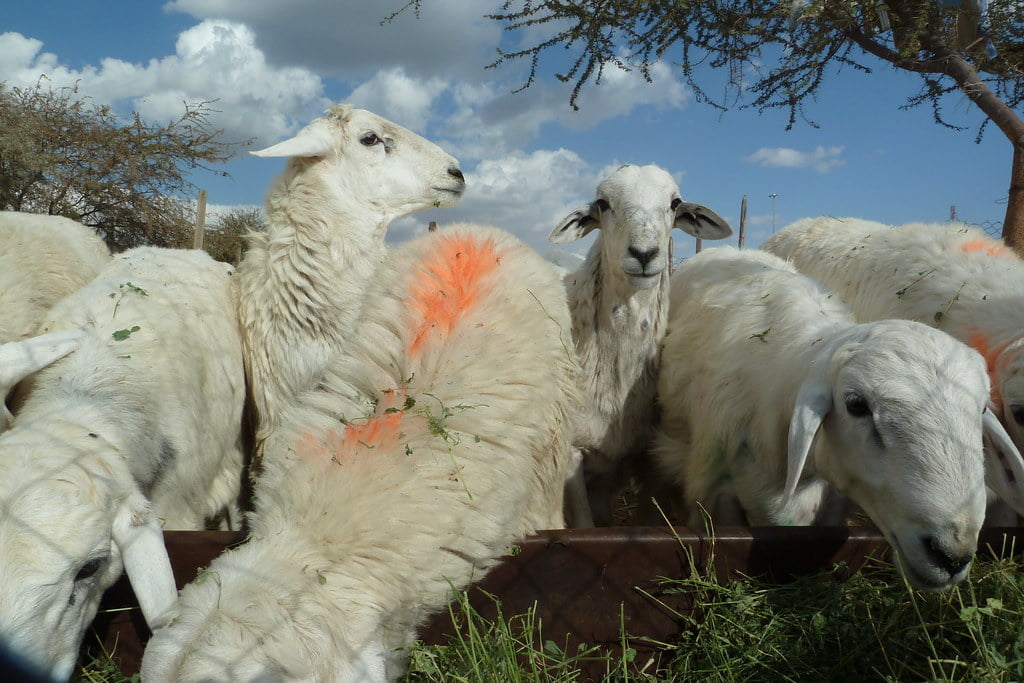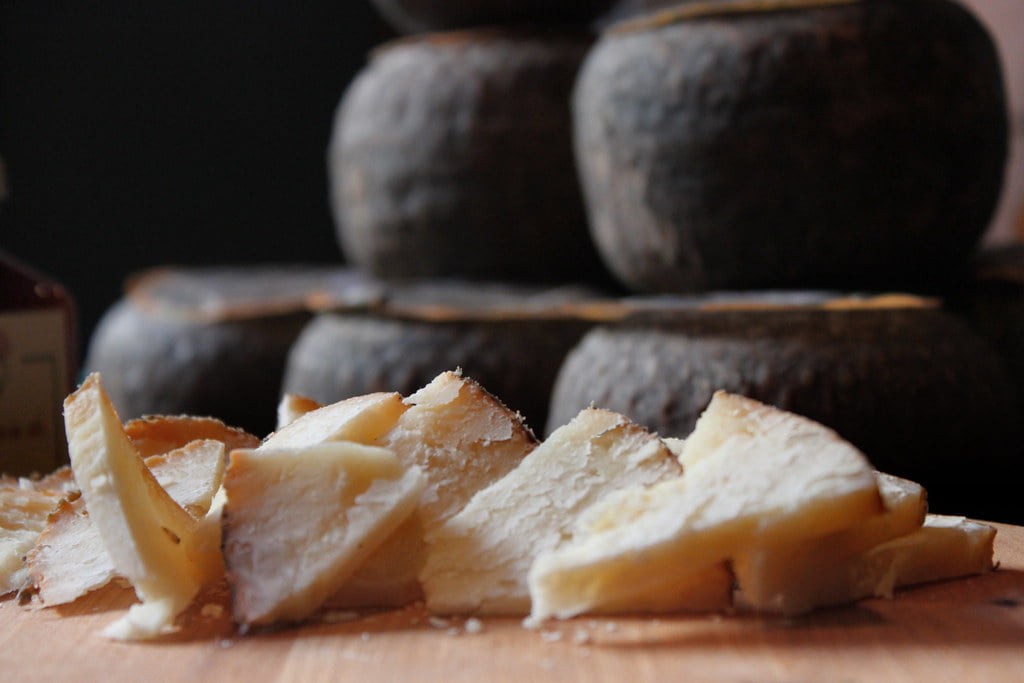Cheese comes in endless varieties, each with its unique textures, flavors, and best uses. Whether you’re looking to expand your palate, improve your cheese board, cook with new varieties, or simply gain a better appreciation for this beloved food, understanding the major cheese types is essential.
In this guide, we’ll cover different cheese categories, from fresh and bloomy rind to washed rind and firm cheeses. You’ll learn texture profiles, taste notes, wine pairings, and the best ways to eat and cook with each variety.
Fresh Cheese

Fresh cheeses are unripened, meaning they are ready to eat soon after they’ve been made. They have a light, moist texture and mild, subtle flavors without an aging process.
Popular varieties include cottage cheese, cream cheese, ricotta, mozzarella, mascarpone, queso fresco, paneer, and chèvre (fresh goat cheese). These spreadable, spoonable fresh cheeses are versatile ingredients in cooking, baking, and cheese boards.
- Texture: Soft, smooth, creamy
- Taste: Mild, milky flavors
- Best Uses: Cooking, spreading on bread, cheese boards, snacks
- Wine Pairings: Sparkling wines, light whites, fruited wines
Bloomy Rind Cheese
Bloomy rind cheeses are ripened from the outside-in, allowing a thin layer of white mold to grow on the exterior. This protects the soft interior cheese, resulting in a rich, creamy paste with flavors that range from mild to earthy with notes of mushrooms or nuts.
Famous bloomy rind cheeses include Brie and Camembert. Lesser-known varieties like Robiola Due Latti (a blend of cow and sheep milk) also spotlight this signature style. Serve them warm, baked, or at room temperature alongside bread, fruit, and wine.
- Texture: Soft, creamy, oozy interior
- Taste: Rich, butter, mushroom, grassy
- Best Uses: Cheese boards, fondue, panini, tarts
- Wine Pairings: Full-bodied Chardonnay, Sauvignon Blanc, sparkling wines
Washed Rind Cheese
Washed rind refers to the process of regularly washing the cheese exterior with brine, beer, wine, or other liquids during aging. This encourages flavorful bacteria to grow on the rind and creamy interior, producing punchy, pungent cheeses.
Famous examples include Époisses de Bourgogne, Taleggio, and Pont l’Évêque. Oftentimes described as “stinky cheeses”, they make bold additions to cheese plates and pair wonderfully with beer or fruity wines that can stand up to their strong aromas.
- Texture: Soft, smooth, sticky interior
- Taste: Pungent, earthy, salty, fruity
- Best Uses: Cheese boards, panini, grilled cheese
- Wine Pairings: Sweet whites (Sauternes), fruity reds (Pinot Noir, Grenache)
Blue Cheese
During production, blue cheeses are inoculated with a specific mold that creates “blue” veins running through the interior. This mold imparts a distinct flavor profile ranging from savory to sweet and nutty.
Famous blues include Roquefort (made from sheep milk), Stilton (from England), Gorgonzola (from Italy), and Cabrales (a Spanish blue made from a blend of cow, goat, and sheep milk). Generous crumbles make flavorful additions to salads, pizza, pasta, and more.
- Texture: Can range from soft to crumbly
- Taste: Salty, sweet, tangy, pungent, spicy
- Best Uses: Salad topper, chicken topping, cheese boards
- Wine Pairings: Sweet wines (Port), bold reds (Malbec, Shiraz)
Hard Cheese
Hard cheeses have lower moisture content and undergo longer aging times, resulting in firm textures that allow for grating and shredding. Their complexity of flavors ranges from sharp to nutty and caramelized.
Famous hard cheeses include Cheddar, Parmigiano-Reggiano, Pecorino Romano, Manchego, Gruyère, and Asiago. They hold up wonderfully to cooking methods like grilling and are perfect for snacking, cheese boards, sandwiches, casseroles, and more.
- Texture: Hard, gratable
- Taste: Ranges from mild to very sharp
- Best Uses: Grating, melting, snacking, cheese boards
- Wine Pairings: Bold Cabernet Sauvignon, Tempranillo, Nebbiolo
Semi-Hard Cheese
Semi-hard cheeses fall between soft and hard in moisture content. Their texture allows for good melting properties while still being firm enough for slicing and snacking. Signature flavors lean towards nutty, sweet and tangy notes.
Popular varieties include Gouda, Edam, Fontina, Monterey Jack, Havarti, and Provolone. Aged versions like aged Gouda develop crunchy protein crystals and deeper caramel flavors. Semi-hard cheeses make excellent sandwiches, pair well with fruits and cured meats, and melt beautifully.
- Texture: Firm yet flexible interior
- Taste: Ranges from mild to nutty, sweet, tangy
- Best Uses: Melting, sandwiches, cheese boards
- Wine Pairings: Juicy Cabernet Sauvignon, Rioja, Zinfandel
Goat’s Milk Cheese (Chèvre)
Goat’s milk offers a unique flavor profile thanks to the small fat globules in the milk. Goat cheeses (chèvres) often have a tart, tangy, earthy quality with some grassy or nutty notes.
Some goat milk favorites include Humboldt Fog (with a line of edible vegetable ash through the middle), Valençay (a pyramid-shaped aged goat cheese), and Montrachet (a soft, spreadable log). Goat cheeses pair wonderfully with honey and fruit preserves.
- Texture: Ranges from soft to semi-firm
- Taste: Tangy, tart, earthy, grassy
- Best Uses: Cheese boards, salads, tartines
- Wine Pairings: Sauvignon Blanc, Chenin Blanc, Vinho Verde
Sheep’s Milk Cheese

Sheep’s milk offers rich flavor compounds that translate into complex, nutty cheeses with hints of caramel and grassiness. Signature varieties include Manchego (from Spain), Pecorino Romano and Pecorino Toscano (from Italy). Aged, grana-style sheep milk cheeses like Grana Padano can take on an almost crumbly texture with sweet, nutty notes.
- Texture: Ranges from semi-soft to very hard
- Taste: Sweet, nutty, rich, grassy
- Best Uses: Grating, snacking, cheese boards
- Wine Pairings: Cabernet Sauvignon, Sangiovese, Nebbiolo
Hybrid Cheeses
Some cheeses combine milks from multiple animals. Blending milks allows cheesemakers to balance flavor compounds and fat and protein levels.
For example, Italy’s Robiola Due Latti mixes cow and sheep milk. Cypress Grove Chevre’s Lamb Chopper marries goat and sheep milk. These unique hybrids layer flavors and textures into creative new cheeses.
Key Takeaways: Choosing Cheese
- Consider the taste, texture, and wine pairing you desire
- Softer cheeses work well for cooking, spreading, and creamier dishes
- Hard, aged cheeses are great for grating, shredding, snacking, and bold wine pairings
- Match intensities – pair pungent cheeses with equally full-bodied wines
- Contrast intensities – cut strong cheeses with sweet or fruity flavors
- Use cheese as a way to explore new wine varieties and milk types
FAQs About Cheese
What’s the healthiest cheese?
Some good options for healthier cheeses include part-skim mozzarella, cottage cheese, goat cheese, feta cheese, and Parmesan cheese. These all supply lower amounts of saturated fat and higher amounts of bone-strengthening calcium.
What ingredients make blue cheese blue?
During production, veins of a mold called Penicillium roqueforti are intentionally introduced. These blue mold spores impart tangy, pungent, and sometimes sweet flavor notes, creating a blue cheese’s signature appearance and taste.
What are those white crystals in aged cheeses?
Those little white bits in extra aged cheeses like aged Gouda are crunchy protein clusters called “cheese crystals” or tyrosine crystals. As cheeses lose moisture during aging, milk proteins cram together forming these tasty, crystalline structures.
What’s the difference between Asiago and Parmigiano Reggiano?
Both are hard, aged cow’s milk cheeses from Italy. But Asiago comes from the Asiago plateau of Veneto/T

